

高等学校化学学报 ›› 2021, Vol. 42 ›› Issue (2): 412.doi: 10.7503/cjcu20200673
林生晃,傅年庆,鲍桥梁
收稿日期:2020-09-10
出版日期:2021-02-10
发布日期:2020-12-28
基金资助:
LIN Shenghuang1,4( ), FU Nianqing2(
), FU Nianqing2( ), BAO Qiaoliang3(
), BAO Qiaoliang3( )
)
Received:2020-09-10
Online:2021-02-10
Published:2020-12-28
Contact:
LIN Shenghuang,FU Nianqing,BAO Qiaoliang
E-mail:linshenghuang@sslab.org.cn;msnqfu@scut.edu.cn;Qiaoliang.Bao@gmail.com
Supported by:摘要:
随着环境污染的日益严重和能源危机的不断加剧, 新能源的开发和利用逐渐成为研究的重点. 在各种已开发的绿色能源技术中, 光伏发电是一种非常有前景的技术. 尽管传统硅基太阳能电池已取得长足进步, 但其性价比与传统能源相比仍有差距. 因此, 开发低成本高效太阳能电池迫在眉睫, 但新型太阳能电池的应用仍受到稳定性差与效率较低的双重考验. 在前期研究基础上, 人们将化学和物理性能优异的单元素二维材料及其衍生物作为电荷传输层引入太阳能电池中, 在改善电池稳定性及提升效率方面取得了积极的效果. 本文综合评述了纳米级单元素二维材料及其衍生物作为太阳能电池电荷传输层的相关研究进展. 这些单元素材料的引入使得所研究的太阳能电池效率得到了显著的提高, 同时也证明该类型电荷传输层的构建为满足现代社会能源需求提供了新技术平台. 文章最后讨论了单元素二维材料在太阳能电池中应用面临的关键挑战和发展前景.
中图分类号:
TrendMD:
林生晃, 傅年庆, 鲍桥梁. 单元素二维材料及其衍生物作为电荷传输层在太阳能电池中应用的研究进展. 高等学校化学学报, 2021, 42(2): 412.
LIN Shenghuang, FU Nianqing, BAO Qiaoliang. Recent Advances in the Applications of Elemental Two-dimensional Materials and Their Derivatives Serving as Transport Layers in Solar Cells. Chem. J. Chinese Universities, 2021, 42(2): 412.
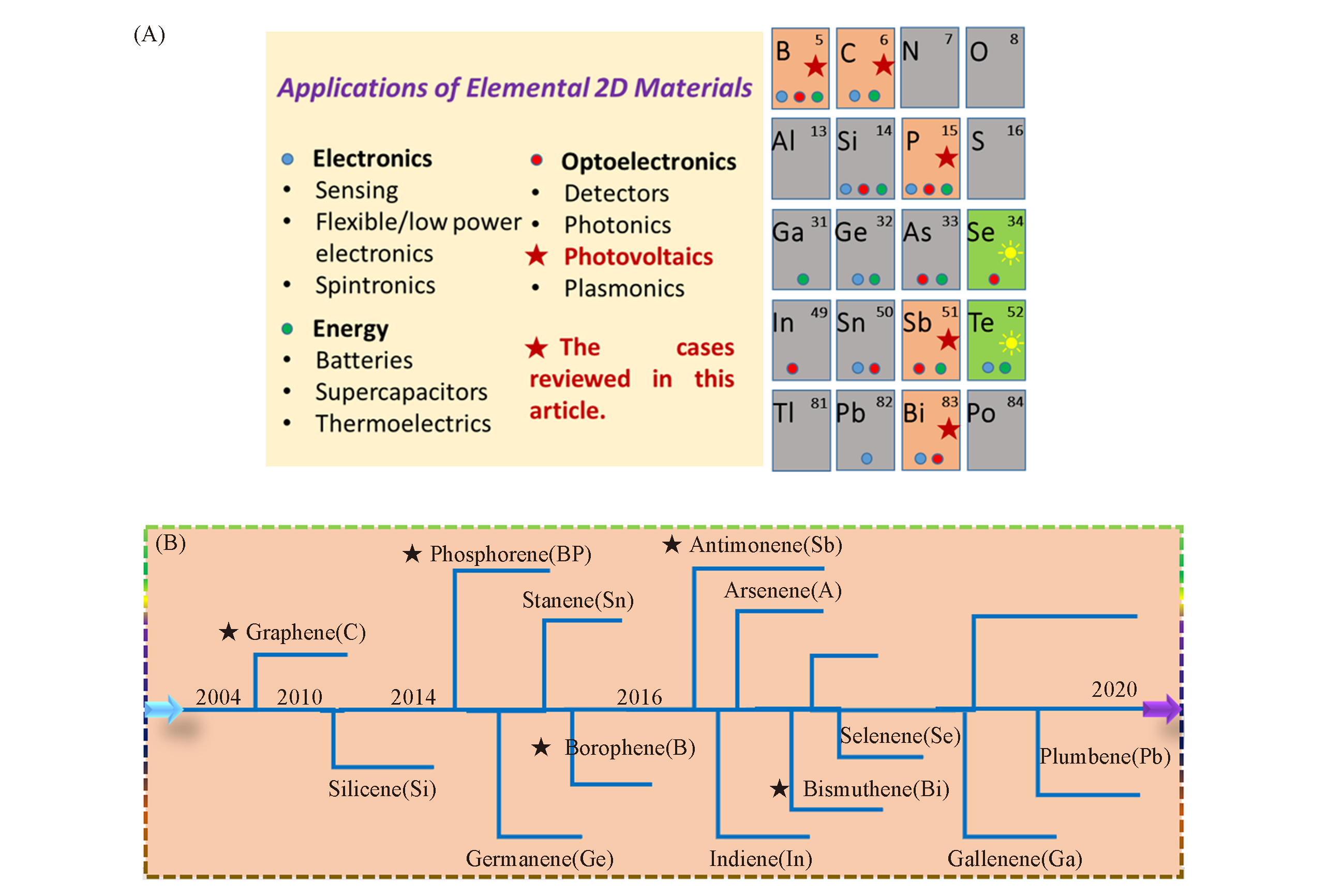
Fig.2 Overview of elemental 2D materials explored through experimental or theoretical approaches(A) and a roadmap of several recent elemental 2D materials being investigated in experiments or theory(B)The pentagram star in (A) reveals the cases we studied in this work.
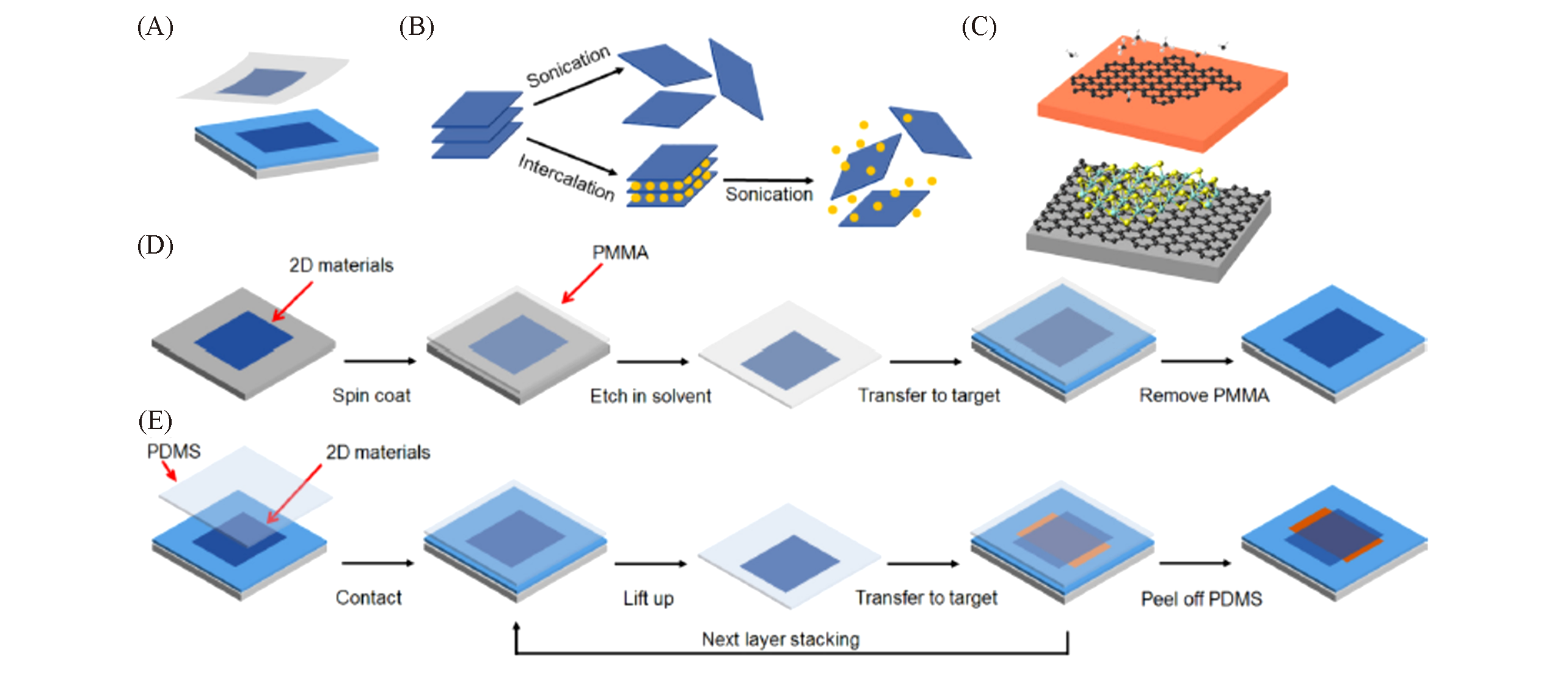
Fig.3 Mechanical exfoliation(A), liquid?phase exfoliation(B) and CVD(C) approaches for the synthesis of 2D materials[48]Copyright 2017, American Institute of Physics.
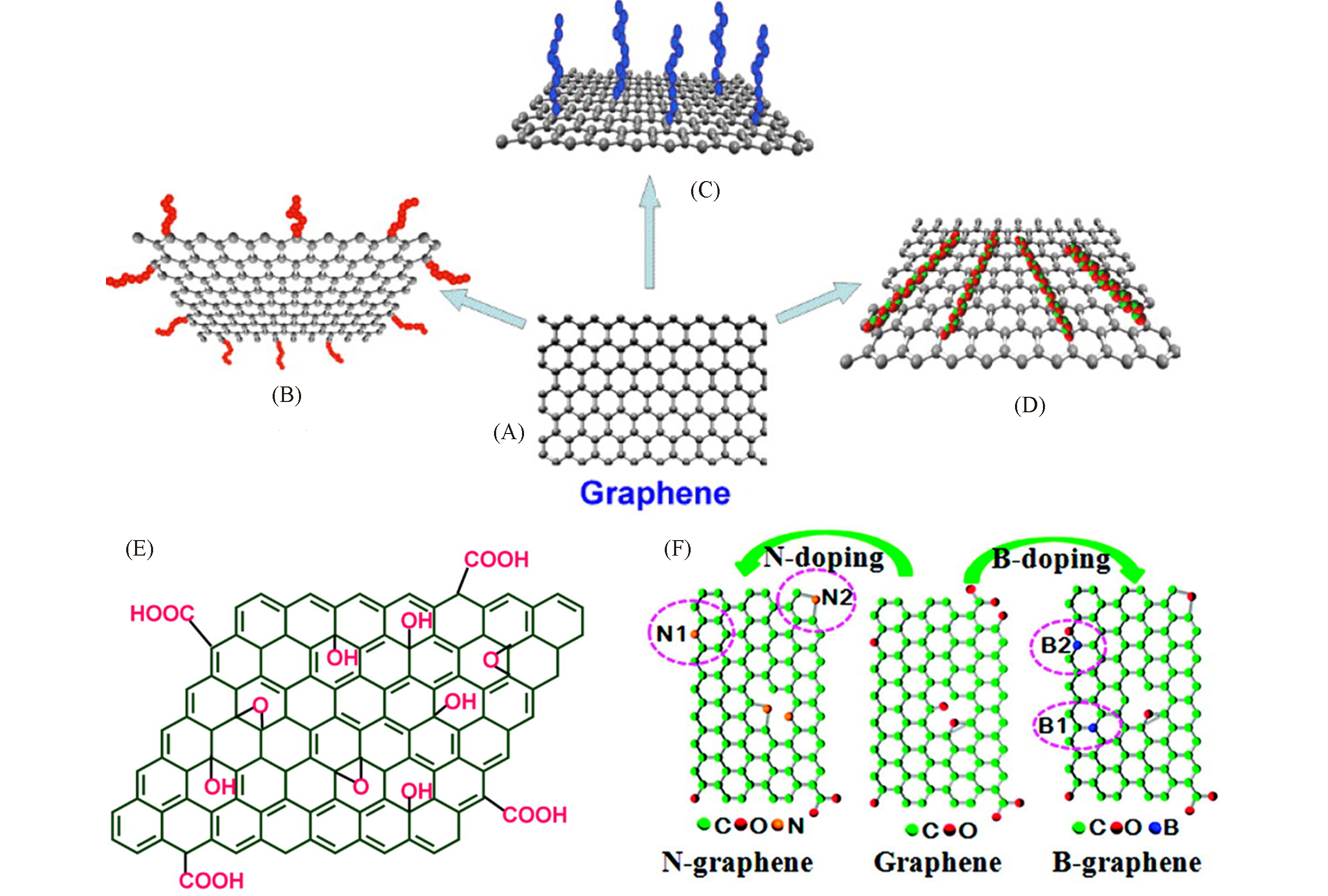
Fig.4 Schematic illustration of functionalized graphene by various strategies[99](A) Pristine grapheme; (B) edge-functionalization; (C) basal-plane-functionalization; (D) noncovalent adsorption on the basal plane; (E) chemical structure of graphene oxide(GO)[99]. Copyright 2013, American Chemical Society. (F) Schematic structure of N- and B-doped graphene[100]. Copyright 2011, American Chemical Society.
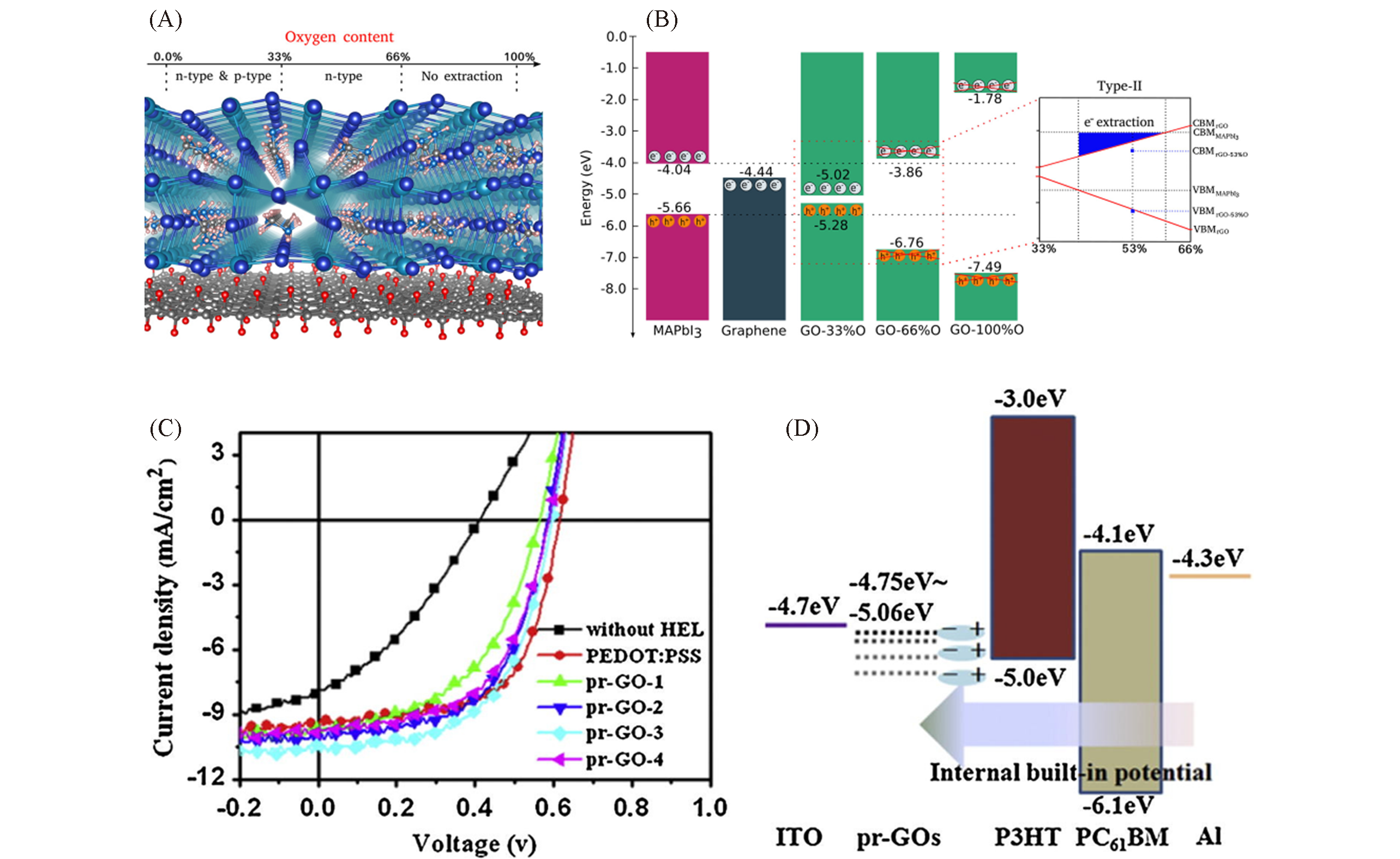
Fig.5 Theoritical and experimental results of tuning oxygen concentration in GO transport layers for enhancing the PCE of OPV devices(A) Schematical representation of the conduction-type of the GO/CH3NH3PbI3 with the oxidation level of GO; (B) energy-level alignment within the GO/CH3NH3PbI3 heterojunctions. The red cross-lines in rGO-66%O and GO-100%O indicate a forbidden charge transfer(The inset highlights the interpolated band alignment between rGO-33%O and rGO-66%O, where the blue-shaded area corresponds to a type II heterojunction)[117]. Copyright 2018, The Royal Society of Chemistry. (C) J?V curve of devices based on ITO/HEL/P3HT:PC61BM/LiF/Al structure, with HEL of PEDOT:PSS, graphene oxide with varied oxidation(pr-GO) and HEL-free; (D) energy level diagram of device[118]. Copyright 2014, Elsevier.
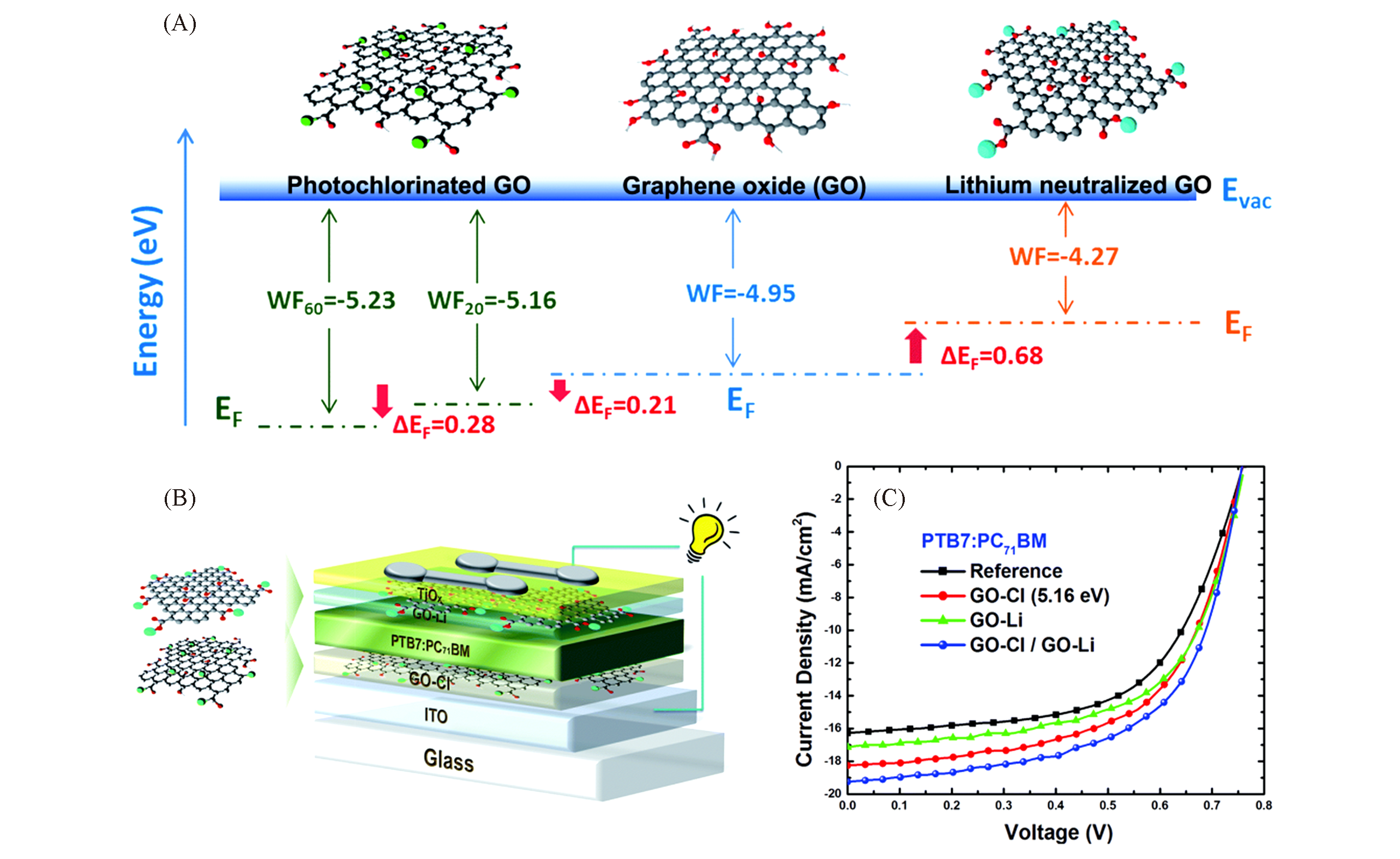
Fig.6 Tuning the energy band of GO by chemical dopping and its performance on organic solar cells[130](A) Energy diagram showing the Fermi level of GO(middle) and its shifting after the functionalization with Cl(left) and Li(right); (B) schematic illustration of the BHJ OPV device with GO-Cl as the HTL and GO-Li/TiOx as the ETL; (C) J?V characteristics of PTB7:PC71BM-based photovoltaic devices. Copyright 2016, Royal Society of Chemistry.
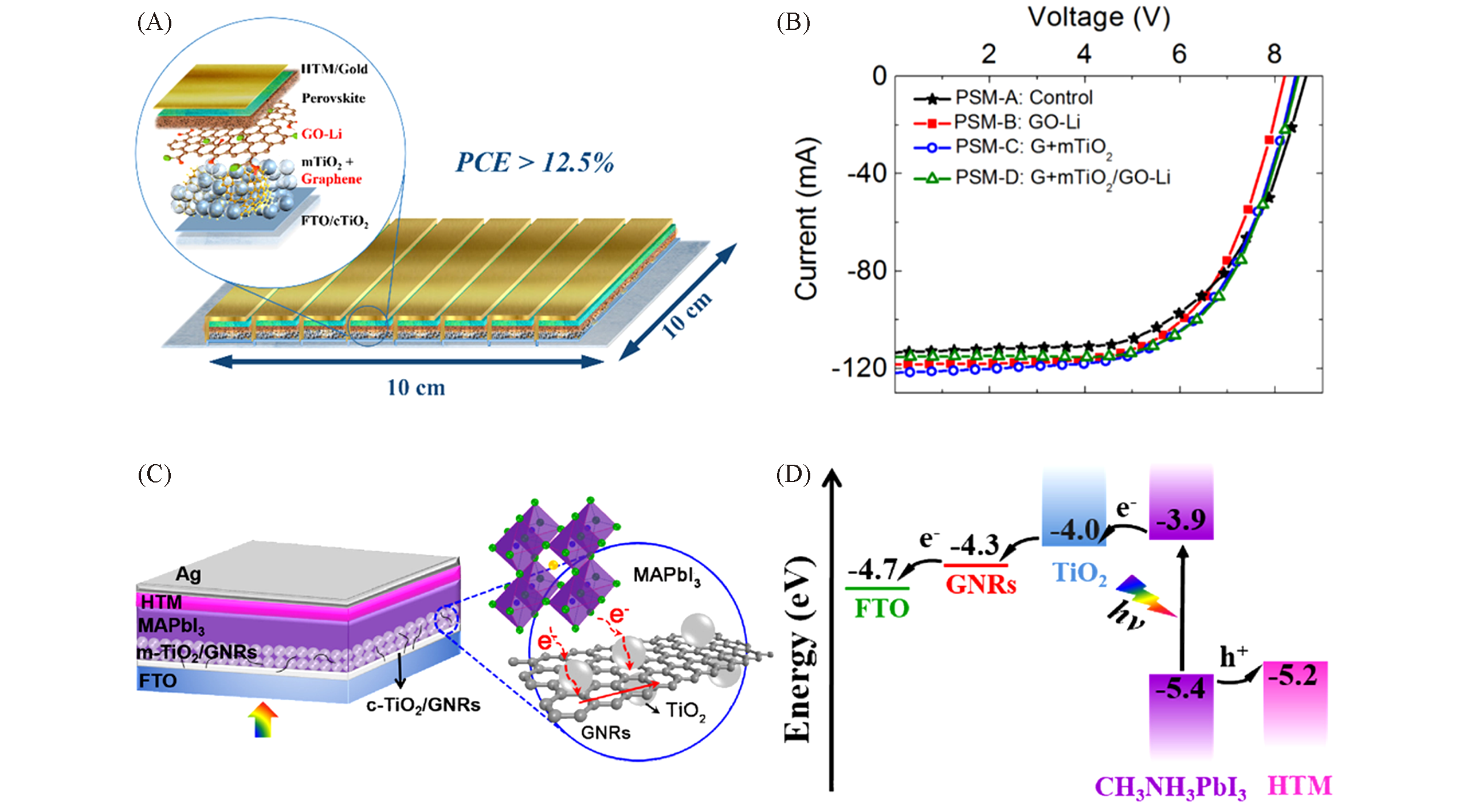
Fig.7 Chemical doped GO and its performance in perovskite solar cells(A) Schematic representation of PSCs-module structure with graphene and GO-Li inclusion; (B) the current-voltage(I?V) characteristics of tested modules[143]. Copyright 2017, American Chemical Society. (C) Schematic illustration of device architecture; (D) energy level diagram of m-PSC with GNRs incorporated into TiO2 ETL[145]. Copyright 2018, Elsevier.
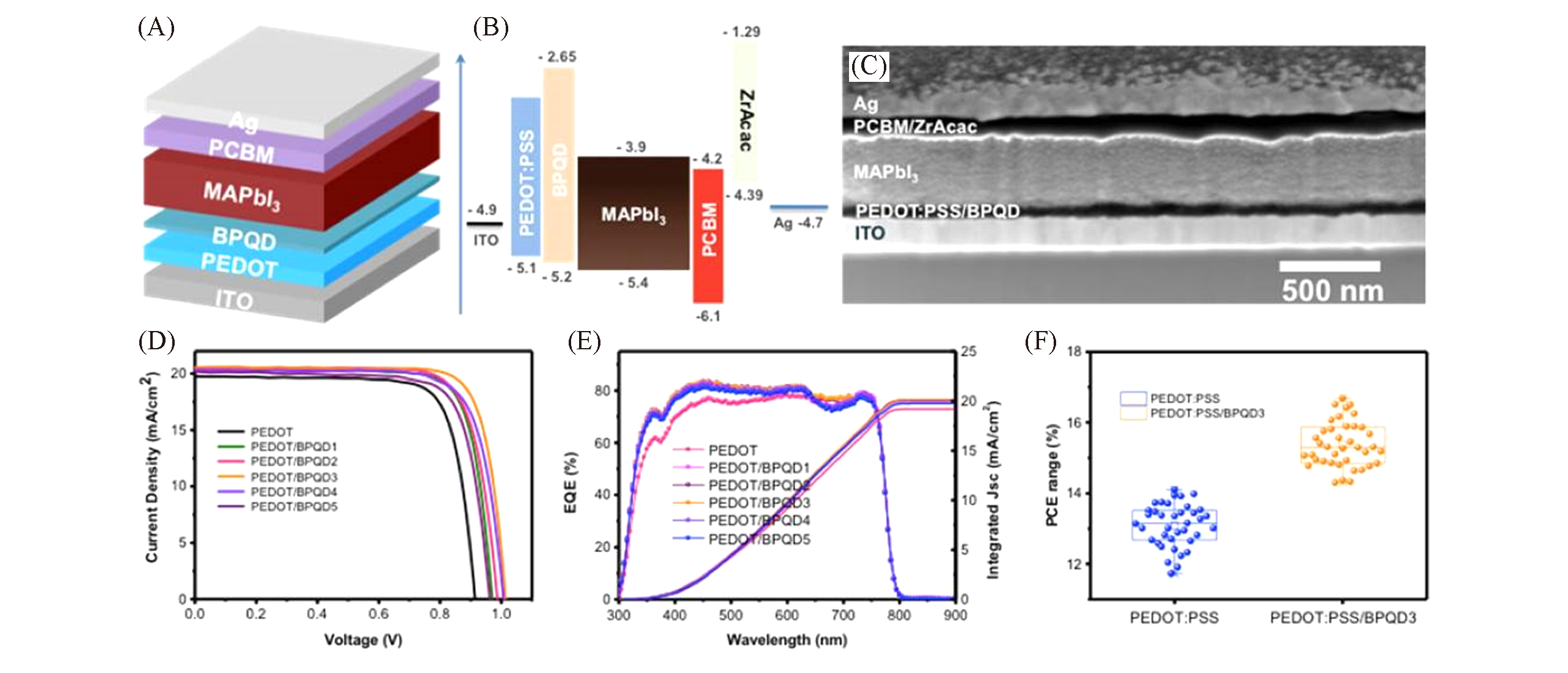
Fig.8 BPQD as hole transport material in perovskite solar cells[158](A) Configuration of the p-i-n planar PSCs; (B) energy level diagram of each functional layer; (C) cross-section SEM of an optimal device; (D) J?V curves of PSCs in a forward scan, measured under 100 mW/cm2 illumination; (E) EQE spectra of the optimal PSCs with different times(0—5) of BPQDs coating as interlayers; (F) device performance statistics for the PSCs with BPQD and without BPQD as interlayers. Copyright 2017, American Chemical Society.
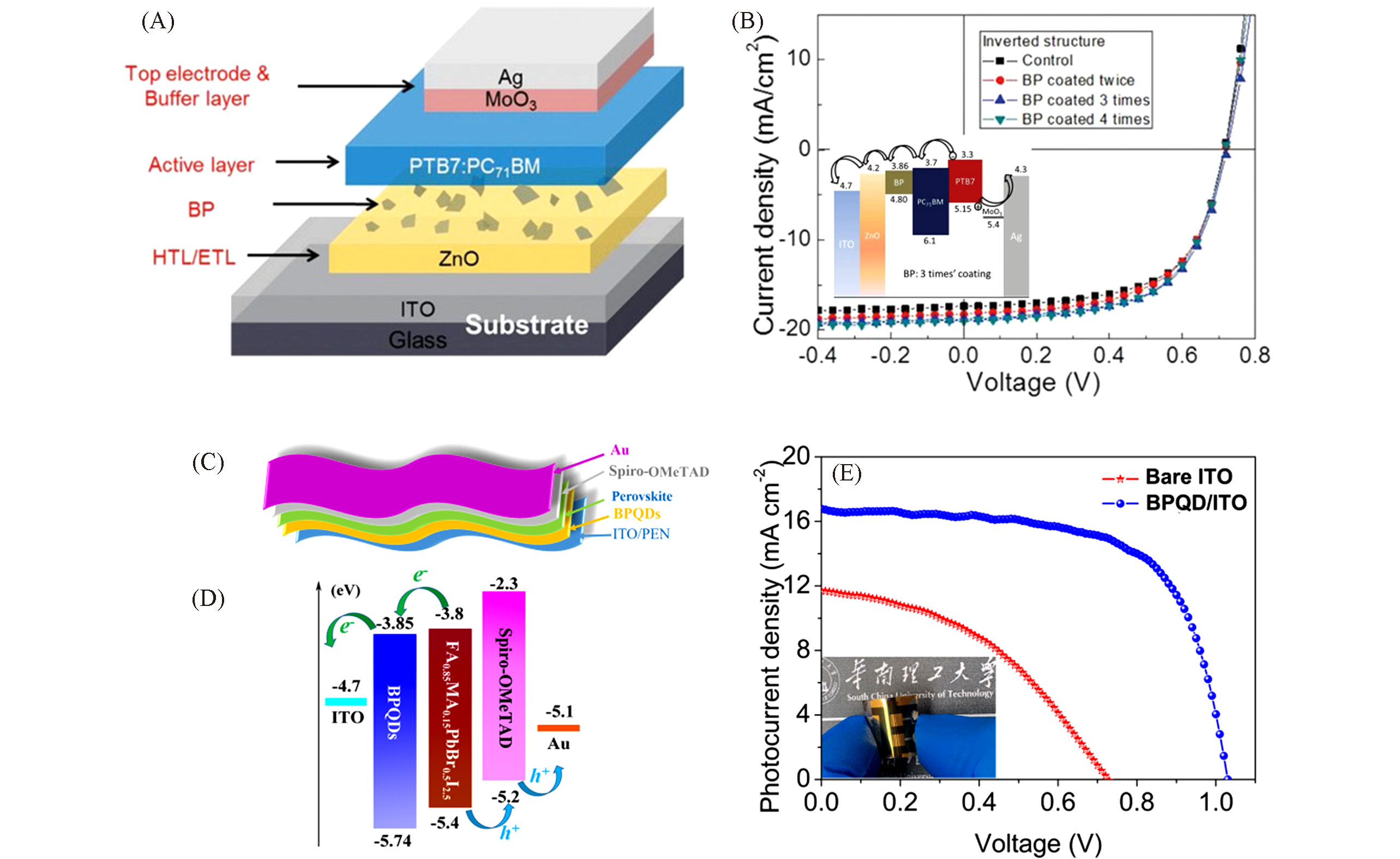
Fig.9 BPQD as electron transport materials for organic solar cell and perovskite solar cell(A) The inverted architectures and of OPVs based on PTB7/PC71BM;(B) J?V characteristics of inverted OPVs with BP incorporation under different conditions(the inset of (B) shows the energy band structure of the OPV based on PTB7/PC71BM with the incorporation of BP, three times coating)[161]. Copyright 2016, WILEY‐VCH Verlag GmbH & Co. KGaA, Weinheim. (C) Schematic illustration of the plastic organic-inorganic perovskite solar cells with BPQDs ETL; (D) energy level diagram of each component of PSCs; (E) J?V characteristic curves of PSCs built on BPQDs electron selective layer(ESL) and bare ITO substrate, measured under 1 sun illumination(100 mW/cm2) in a reverse scan[7]. Copyright 2018, The Royal Society of Chemistry.
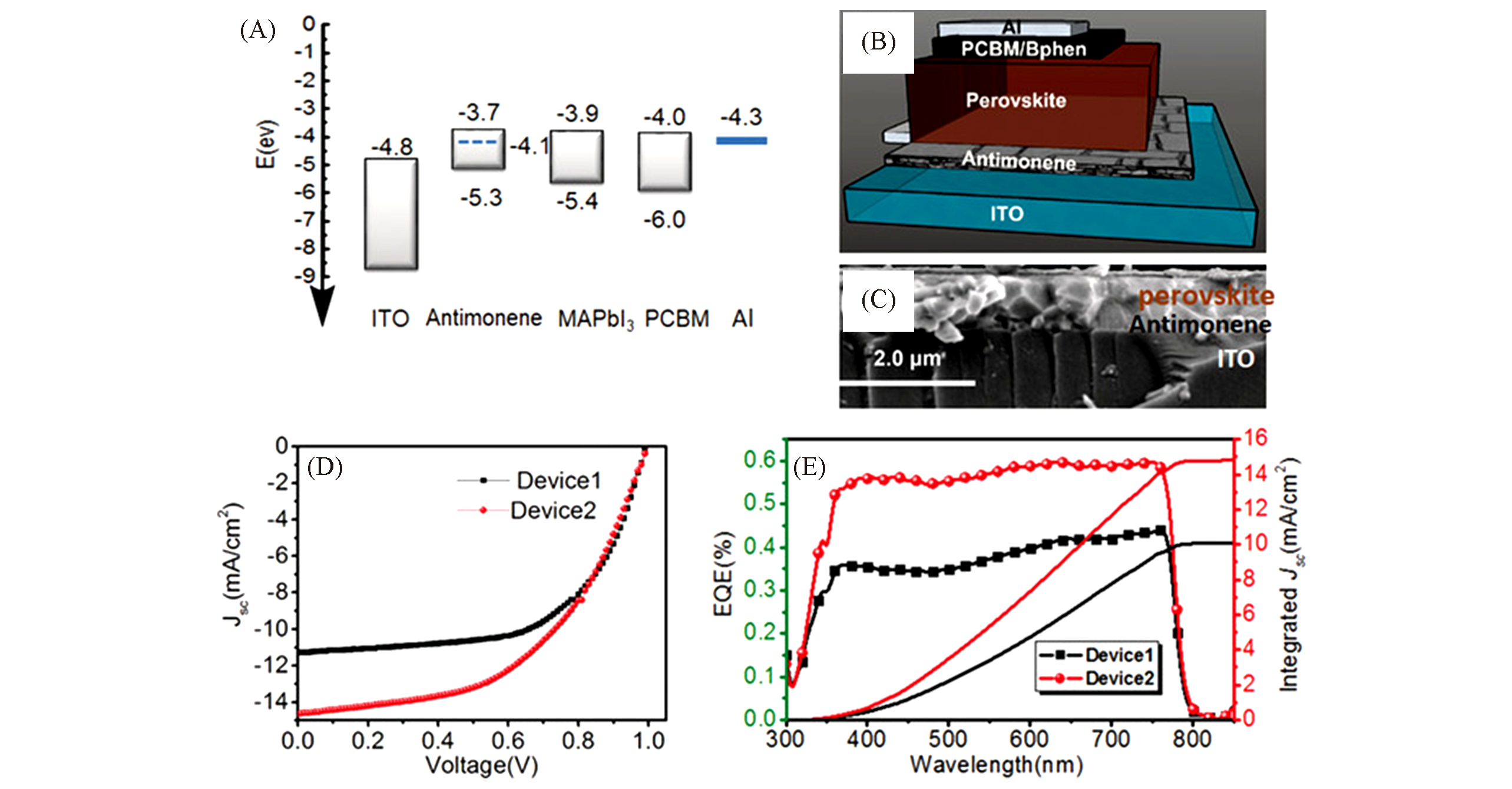
Fig.10 Antimonene as electron transport materials for perovskite solar cells[168](A) The energy levels of each functional layer of PSC with an antimonene HTL; (B) configuration of the antimonene-based device;(C) cross-sectional SEM image of the device; (D, E) J?V curves(D) and external quantum efficiency(EQE) spectra(E) of devices without HTL(Device 1) and with antimonene HTL(Device 2). Copyright 2018, WILEY‐VCH Verlag GmbH & Co. KGaA, Weinheim.
| 1 | Novoselov K. S., Geim A. K., Morozov S. V., Jiang D., Zhang Y., Dubonos S. V., Grigorieva I. V., Firsov A. A., Science, 2004, 306, 666—669 |
| 2 | Mak K.F., Lee C., Hone J., Shan J., Heinz T.F., Phys. Rev. Lett., 2010, 105, 136805 |
| 3 | Georgiou T., Jalil R., Belle B. D., Britnell L., Gorbachev R. V., Morozov S. V., Kim Y., Gholinia A., Haigh S. J., Makarovsky O., Eaves L., Ponomarenko L. A., Geim A. K., Novoselov K. S., Mishchenko A., Nat. Nanotechnol., 2013, 8, 100—103 |
| 4 | Li L., Yang F., Ye G. J., Zhang Z., Zhu Z., Lou W., Zhou X., Li L., Watanabe K., Taniguchi T., Chang K., Wang Y., Chen X. H., Zhang Y., Nat Nanotechnol., 2016, 11, 593 |
| 5 | Liu S., Lin S., You P., Surya C., Lau S., Yan F., Angew. Chem., 2017, 129, 13905—13909 |
| 6 | Lin S., Li Y., Lu W., Chui Y., Rogée L., Bao Q., Lau S., 2D Mater., 2017, 4, 025001 |
| 7 | Fu N., Huang C., Lin P., Zhu M., Li T., Ye M., Lin S., Zhang G., Du J., Liu C., Xu B., Wang D., Ke S., J. Mater. Chem. A, 2018, 6, 8886—8894 |
| 8 | Yuan J., Sun T., Hu Z., Yu W., Ma W., Zhang K., Sun B., Lau S. P., Bao Q., Lin S., Li S., ACS Appl. Mater. Interfaces, 2018, 10, 40614—40622 |
| 9 | Lin S., Liu Y., Hu Z., Lu W., Mak C., Zeng L., Zhao J., Li Y., Yan F., Tsang Y., Zhang X., Lau S., Nano Energy, 2017, 42, 26—33 |
| 10 | Yuan J., Mu H., Li L., Chen Y., Yu W., Zhang K., Sun B., Lin S., Li S., Bao Q., ACS Appl. Mater. Interfaces, 2018, 10, 21534—21540 |
| 11 | Castellanos⁃Gomez A., Nat. Photonics, 2016, 10, 202 |
| 12 | Glavin N. R., Rao R., Varshney V., Bianco E., Apte A., Roy A., Ringe E., Ajayan P. M., Adv. Mater., 2019, 32, 1904302 |
| 13 | Mannix A. J., Kiraly B., Hersam M. C., Guisinger N. P., Nat. Rev. Chem., 2017, 1, 0014 |
| 14 | Zhang Y., Rubio A., Lay G., J. Phys. D: Appl. Phys., 2017, 50, 053004 |
| 15 | Bachra M. E., Zaari H., Benyoussef A., Kenz A. E., Hachimi A. G. E., J. Supercond. Novel Magn., 2018, 31, 2579—2588 |
| 16 | Broek B. V. D., Houssa M., Scalise E., Pourtois G., Afanas’ev V. V., Stesmans A., 2D Mater., 2014, 1, 021004 |
| 17 | Matusalem F., Marques M., Teles L. K., Bechstedt F., Phys. Rev. B, 2015, 92, 045436 |
| 18 | Şahin H. Cahangirov S., Topsakal M., Bekaroglu E., Akturk E., Senger R. T., Ciraci S., Phys. Rev. B, 2009, 80, 155453 |
| 19 | Tang P. Chen P., Cao W., Huang H., Cahangirov S., Xian L., Xu Y., Zhang S. C., Duan W., Rubio A., Phys. Rev. B, 2014, 90, 121408 |
| 20 | Xu Y., Tang P., Zhang S. C., Phys. Rev. B, 2015, 92, 081112 |
| 21 | Takeda K., Shiraishi K., Phys. Rev. B, 1994, 50, 14916 |
| 22 | Cahangirov S., Topsakal M., Aktürk E., Şahin H., Ciraci S., Phys. Rev. Lett., 2009, 102, 236804 |
| 23 | Dávila M. E., Xian L., Cahangirov S., Rubio A., Le Lay G., New J. Phys., 2014, 16, 095002 |
| 24 | Zhu F., Chen W., Xu Y., Gao C. L., Guan D. D., Liu C. H., Qian D., Zhang S. C., Jia J. J., Nat. Mater., 2015, 14, 1020—1025 |
| 25 | Vogt P., Padova P. D., Quaresima C., Avila J., Frantzeskakis E., Asensio M. C., Resta A., Ealet B., Lay G. L., Phys. Rev. Lett., 2012, 108, 155501 |
| 26 | Derivaz M., Dentel D., Stephan R., Hanf M., Mehdaoui A., Sonnet P., Pirri C., Nano Lett., 2015, 15, 2510—2516 |
| 27 | Deng J., Xia B., Ma X., Chen H., Shan H., Zhai X., Li B., Zhao A., Xu Y., Duan W., Zhang S., Wang B., Hou J. G., Nat. Mater., 2018, 17, 1081—1086 |
| 28 | Aufray B., Kara A., Vizzini S., Oughaddou H., Léandri C., Ealet B., Lay G. L., Appl. Phys. Lett., 2010, 96, 183102 |
| 29 | Mannix A. J., Zhou X. F., Kiraly B., Wood J. D., Alducin D., Myers B. D., Liu X., Fisher B. L., Santiago U., Guest J. R., Yacaman M. J., Ponce A., Oganov A. R., Hersam M. C., Guisinger N. P., Science, 2015, 350, 1513—1516 |
| 30 | Lei T., Liu C., Zhao J. L., Li J. M., Li Y. P., Wang J. O., Wu R., Qian H. J., Wang H. Q., Ibrahim K., J. Appl. Phys., 2016, 119, 015302 |
| 31 | Singh D., Gupta S. K., LukacěvićI., Sonvane Y., RSC Adv., 2016, 6, 8006—8014 |
| 32 | Reis F., Li G., Dudy L., Bauernfeind M., Glass S., Hanke W., Thomale R., Schäfer J., Claessen R., Science, 2017, 357, 287—290 |
| 33 | Zhu Z., Cai X., Yi S., Chen J., Dai Y., Niu C., Guo Z., Xie M., Liu F., Cho J. H., Jia Y., Zhang Z., Phys. Rev. Lett., 2017, 119, 106101 |
| 34 | Qin J., Qiu G., Jian J., Zhou H., Yang L., Charnas A., Zemlyanov D. Y., Xu C. Y., Xu X., Wu W., Wang H., Ye P. D., ACS Nano, 2017, 11, 10222—10229 |
| 35 | Kochat V., Samanta A., Zhang Y., Bhowmick S., Manimunda P., Asif S. A. S., Stender A. S., Vajtai R., Singh A. K., Tiwary C. S., Ajayan P. M., Sci. Adv., 2018, 4, e1701373 |
| 36 | Yuhara J., He B., Matsunami N., Nakatake M., Le Lay G., Adv. Mater., 2019, 31, 1901017 |
| 37 | Yeoh K. H. Y., Rusi T. L., Ong D. S., Lim T. L., Appl. Surf. Sci., 2018, 445, 161—166 |
| 38 | Glavin N. R., Rao R., Varshney V., Bianco E., Apte A., Roy A., Ringe E., Ajayan P. M., Adv. Mater., 2019, 32, 1904302 |
| 39 | Huang Y., Shirodkar S. N., Yakobson B. I., J. Am. Chem. Soc., 2017, 139, 17181—17185 |
| 40 | Boustani I., Quandt A., Hernández E., Rubio A., J. Chem. Phys., 1999, 110, 3176 |
| 41 | Tang H., Ismail⁃Beigi S., Phys. Rev. Lett., 2007, 99, 115501 |
| 42 | Wu J., Mao N., Xie L., Xu H., Zhang J., Angew. Chem. Int. Ed., 2015, 54, 2366—2369 |
| 43 | Lam K.T., Dong Z., Guo J., IEEE Electron Device Letters, 2014, 35, 963—965 |
| 44 | Wu X., Shao Y., Liu H., Feng Z., Wang Y. L., Sun J. T., Liu C., Wang J. O., Liu Z. L., Zhu S. Y., Wang Y. Q., Du S. X., Shi Y. G., Ibrahim K., Gao H. J., Adv. Mater., 2017, 29, 1605407 |
| 45 | Wang G., Pandey R., Karna S. P., ACS Appl. Mater. Interfaces, 2015, 7, 11490—11496 |
| 46 | Aktürk E., Aktürk U. O., Ciraci S., Phys. Rev. B, 2016, 94, 014115 |
| 47 | Lu Y., Xu W., Zeng M., Yao G., Shen L., Yang M., Luo Z., Pan F., Wu K., Das T., He P., Jiang J., Martin J., Feng Y. P., Lin H., Wang X. S., Nano Lett., 2015, 15, 80—87 |
| 48 | Li X., Tao L., Chen Z., Fang H., Li X., Wang X., Xu J., Zhu H., Appl. Phys. Rev., 2017, 4, 021306 |
| 49 | Lin S., Chui Y., Li Y., Lau S., FlatChem, 2017, 2, 15—37 |
| 50 | Hernandez Y., Nicolosi V., Lotya M., Blighe F. M., Sun Z., De S., McGovern I. T., Holland B., Byrne M., Gun’Ko Y. K., Boland J. J., Niraj P., Duesberg G., Krishnamurthy S., Goodhue R., Hutchison J., Scardaci V., Ferrari A. C., Coleman J. N., Nat. Nanotechnol., 2008, 3, 563—568 |
| 51 | Gu W., Zhang W., Li X., Zhu H., Wei J., Li Z., Shu Q., Wang C., Wang K., Shen W., Kang F., Wu D., J. Mater. Chem., 2009, 19, 3367—3369 |
| 52 | Zeng Z., Yin Z., Huang X., Li H., He Q., Lu G., Boey F., Zhang H., Angew. Chem., Int. Ed., 2011, 50, 11093—11097 |
| 53 | Coleman J. N., Lotya M., O’Neill A., Bergin S. D., King P. J., Khan U., Young K., Gaucher A., De S., Smith R. J., Shvets I. V., Arora S. K., Stanton G., Kim H. Y., Lee K., Kim G. T., Duesberg G. S., Hallam T., Boland J. J., Wang J. J., Donegan J. F., Grunlan J. C., Moriarty G., Shmeliov A., Nicholls R. J., Perkins J. M., Grieveson E. M., Theuwissen K., McComb D. W., Nellist P. D., Nicolosi V., Science, 2011, 331, 568—571 |
| 54 | Zheng J., Zhang H., Dong S., Liu Y., Nai C. T., Shin H. S., Jeong H. Y., Liu B., Loh K. P., Nat. Commun., 2014, 5, 2995 |
| 55 | Li X., Cai W., An J., Kim S., Nah J., Yang D., Piner R., Velamakanni A., Jung I., Tutuc E., Banerjee S. K., Colombo L., Ruoff R. S., Science, 2009, 324, 1312—1314 |
| 56 | Bae S., Kim H., Lee Y., Xu X., Park J., Zheng Y., Balakrishnan J., Lei T., Kim H. R., Song Y., Kim Y., Kim K. S., Ozyilmaz B., Ahn J., Hong B. H., Iijima S., Nat. Nanotechnol., 2010, 5, 574—578 |
| 57 | Reina A., Jia X., Ho J., Nezich D., Son H., Bulovic V., Dresselhaus M. S., Kong J., Nano Lett., 2009, 9, 30—35 |
| 58 | Kim K. S., Zhao Y., Jang H., Lee S. Y., Kim J. M., Kim K. S., Ahn J. H., Kim P., Choi J., Hong B. H., Nature, 2009, 457, 706—710 |
| 59 | Sun Z., Yan Z., Yao J., Beitler E., Zhu Y., Tour J. M., Nature, 2010, 468, 549—552 |
| 60 | Li Z., Wu P., Wang C., Fan X., Zhang W., Zhai X., Zeng C., Li Z., Yang J., Hou J., ACS Nano, 2011, 5, 3385—3390 |
| 61 | Wan X., Chen K., Liu D., Chen J., Miao Q., Xu J., Chem. Mater., 2012, 24, 3906—3915 |
| 62 | Li X., Cai W., Colombo L., Ruoff R. S., Nano Lett., 2009, 9, 4268—4272 |
| 63 | Song L., Ci L., Lu H., Sorokin P. B., Jin C., Ni J., Kvashnin A. G., Kvashnin D. G., Lou J., Yakobson B. I., Ajayan P. M., Nano Lett., 2010, 10, 3209—3215 |
| 64 | Kim K. K., Hsu A., Jia X., Kim S. M., Shi Y., Hofmann M., Nezich D., Rodriguez⁃Nieva J. F., Dresselhaus M., Palacios T., Kong J., Nano Lett., 2012, 12, 161—166 |
| 65 | Guo N., Wei J., Jia Y., Sun H., Wang Y., Zhao K., Shi X., Zhang L., Li X., Cao A., Zhu H., Wang K., Wu D., Nano Res., 2013, 6, 602—610 |
| 66 | Kim S. M., Hsu A., Park M. H., Chae S. H., Yun S. J., Lee J. S., Cho D., Fang W., Lee C., Palacios T., Dresselhaus M., Kim K. K., Lee Y. H., Kong J., Nat. Commun., 2015, 6, 8662 |
| 67 | Lee Y. H., Zhang X. Q., Zhang W., Chang M. T., Lin C., Chang K., Yu Y., Wang J. T. W., Chang C., Li L., Lin T., Adv. Mater., 2012, 24, 2320—2325 |
| 68 | Najmaei S., Liu Z., Zhou W., Zou X., Shi G., Lei S., Yakobson B. I., Idrobo J., Ajayan P. M., Lou J., Nat. Mater., 2013, 12, 754—759 |
| 69 | van der Zande A. M., Huang P. Y., Chenet D. A., Berkelbach T. C., You Y., Lee G., Heinz T. F., Reichman D. R., Muller D. A., Hone J. C., Nat. Mater., 2013, 12, 554—561 |
| 70 | Kiraly B., Liu X., Wang L., Zhang Z., Mannix A. J., Fisher B. L., Yakobson B. I., Hersam M. C., Guisinger N. P., ACS Nano, 2019, 13, 3816—3822 |
| 71 | Liu K., Zhang W., Lee Y., Lin Y., Chang M., Su C., Chang C., Li H., Shi Y., Zhang H., Lai C., Li L., Nano Lett., 2012, 12, 1538—1544 |
| 72 | Pirkle A., Chan J., Venugopal A., Hinojos D., Magnuson C. W., McDonnell S., Colombo L., Vogel E. M., Ruoff R. S., Wallace R. M., Appl. Phys. Lett., 2011, 99, 122108 |
| 73 | Lock E. H., Baraket M., Laskoski M., Mulvaney S. P., Lee W. K., Sheehan P. E., Hines D. R., Robinson J. T., Tosado J., Fuhrer M. S., Hernandez S. C., Walton S. G., Nano Lett., 2012, 12, 102—107 |
| 74 | Zhang P., Ma L., Fan F., Zeng Z., Peng C., Loya P. E., Liu Z., Gong Y., Zhang J., Zhang X., Ajayan P. M., Zhu T., Lou J., Nat. Commun., 2014, 5, 3782 |
| 75 | Castellanos⁃Gomez A., Buscema M., Molenaar R., Singh V., Janssen L., van der Zant H. S. J., Steele G. A., 2D Mater., 2014, 1, 011002 |
| 76 | Mainville M., Leclerc M., ACS Energy Lett.,2020, 5, 1186—1197 |
| 77 | Yao H., Wang J., Xu Y., Zhang S., Hou J., Acc. Chem. Res., 2020, 53, 822—832 |
| 78 | Rasi D. D. C., Janssen R. A. J., Adv. Mater.,2019, 31, 1806499 |
| 79 | Lu L., Zheng T., Wu Q., Schneider A. M., Zhao D., Yu L., Chem. Rev., 2015, 115, 12666—12731 |
| 80 | Wang J., Liu K., Ma L., Zhan X., Chem. Rev., 2016, 116, 14675—14725 |
| 81 | Galagan Y., J. Phys. Chem. Lett., 2018, 9, 4326—4335 |
| 82 | Fu N., Zhi Y. B., Zhang Y. L., Zhang G., Ke S., Lin P., Dai J., Huang H., Lei D., Nano Energy, 2017, 41, 654—664 |
| 83 | Tress W., Domanski K., Carlsen B., Agarwalla A., Alharbi E. A., Graetzel M., Hagfeldt A., Nat. Energy, 2019, 4, 568—574 |
| 84 | Park N. G., Zhu K., Nat. Rev. Mater., 2020, 5, 333—350 |
| 85 | Huang C., Lin P., Fu N., Liu C., Xu B., Sun K., Wang D., Zeng X., Ke S., Chem. Commun., 2019, 55, 2777—2780 |
| 86 | NREL Chart: Best Research⁃Cell Efficiencies, https://www.nrel.gov/pv/cell⁃efficiency.html(accessed: 2019) |
| 87 | Hou Y., Quiroz C. O. R., Scheiner S., Chen W., Stubhan T., Hirsch A., Halik M., Brabec C. J., Adv. Energy Mater., 2015, 5, 1501056 |
| 88 | Malinkiewicz O., Yella A., Lee Y. H., Espallargas G. M., Gräetzel M., Nazeeruddin M. K., Bolink H. J., Nat. Photonics,2014, 8, 128—132 |
| 89 | Chen S., Shi G., Adv. Mater., 2017, 29, 1605448 |
| 90 | Balis N., Stratakis E., Kymakis E., Mater. Today, 2016, 19, 580—594 |
| 91 | Bati A. S. R., Batmunkh M., Shapter J. G., Adv. Energy Mater., 2020, 10, 1902253 |
| 92 | Wang B., Iocozzia J., Zhang M., Ye M., Yan S., Jin H., Wang S., Zou Z., Lin Z., Chem. Soc. Rev., 2019, 48, 4854—4891 |
| 93 | Das S., Pandey D., Thomas J., Roy T., Adv. Mater., 2019, 31, 1802722 |
| 94 | Chang D. W., Choi H. J., Filer A., Baek J. B., J. Mater. Chem. A, 2014, 2, 12136—12149 |
| 95 | Geim A. K., Science,2009, 324, 1530—1534 |
| 96 | Geim A. K., Novoselov K. S., Nat. Mater.,2007, 6, 183—191 |
| 97 | Miro P., Audiffred M., Heine T., Chem. Soc. Rev., 2014, 43, 6537—6554 |
| 98 | Schwierz F., Nat. Nanotechnol., 2010, 5, 487—496 |
| 99 | Dai L., Acc. Chem. Res., 2013, 46, 31—42 |
| 100 | Wu Z. S., Ren W., Xu L., Li F., Cheng H. M., ACS Nano, 2011, 5, 5463—5471 |
| 101 | Capasso A., Salamandra L., Faggio G., Dikonimos T., Buonocore F., Morandi V., Ortolani L., Lisi N., ACS Appl. Mater. Interfaces, 2016, 8, 23844—23853 |
| 102 | Bonaccorso F., Balis N., Stylianakis M. M., Savarese M., Adamo C., Gemmi M., Pellegrini V., Stratakis E., Kymakis E., Adv. Funct. Mater., 2015, 25, 3870—3880 |
| 103 | Li Z., Wang Y., Kozbial A., Shenoy G., Zhou F., McGinley R., Ireland P., Morganstein B., Kunkel A., Surwade S. P., Li L., Liu H., Nat. Mater., 2013, 12, 925—931 |
| 104 | Jung S., Lee J., Choi Y., Lee S. M., Yang C., Park H., 2D Mater., 2017, 4, 045004 |
| 105 | Liu Z., You P., Liu S., Yan F., ACS Nano, 2015, 9, 12026—12034 |
| 106 | Mahmoudi T., Wang Y., Hahn Y. B., Nano Energy, 2018, 47, 51—65 |
| 107 | Dreyer D. R., Park S. J., Bielawski C. W., Ruoff R. S., Chem. Soc. Rev., 2010, 39, 228—240 |
| 108 | Boucléa J., Herlin⁃Boime N., Synthetic Met., 2016, 222, 3—16 |
| 109 | Yang D., Zhou L., Chen L., Zhao B., Zhang J., Li C., Chem. Commun., 2012, 48, 8078—8080 |
| 110 | Loh K. P., Bao Q., Eda G., Chhowalla M., Nat. Chem., 2010, 2, 1015—1024 |
| 111 | Li S. S., Tu K. H., Lin C. C., Chen C. W., Chhowalla M., ACS Nano, 2010, 4, 3169—3174 |
| 112 | Smith C. T. G., Rhodes R. W., Beliatis M. J., Jayawardena K. D. G. I., Rozanski L. J., Mills C. A., Silva S. R. P., Appl. Phys. Lett., 2014, 105, 073304 |
| 113 | Wang D. H., Kim J. K., Seo J. H., Park I., Hong B. H., Park J. H., Heeger A. J., Angew. Chem. Int. Ed., 2013, 52, 2874—2880 |
| 114 | Yan K., Wei Z., Li J., Chen H., Yi Y., Zheng X., Long X., Wang Z., Wang J., Xu J., Yang S., Small, 2015, 11, 2269—2274 |
| 115 | Yang Q. D., Li J., Cheng Y., Li H. W., Guan Z., Yu B., Tsang S. W., J. Mater. Chem. A, 2017, 5, 9852—9858 |
| 116 | Le Q. V., Choi J. Y., Kim S. Y., FlatChem, 2017, 2, 54—66 |
| 117 | Zibouche N., Volonakis G., Giustin F., J. Phys. Chem. C, 2018, 122, 16715—16726 |
| 118 | Li C., Yang X., Zhao Y., Zhang P., Tu Y., Li Y., Org. Electron., 2014, 15, 2868—2875 |
| 119 | Eda G., Mattevi C., Yamaguchi H., Kim H., Chhowalla M., J. Phys. Chem. C,2009, 113, 15768—15771 |
| 120 | Eda G., Fanchini, G., Chhowalla M., Nat. Nanotechnol.,2008, 3, 270—274 |
| 121 | Liu X., Kim H., Guo L. J., Org. Electron., 2013, 14, 591—598 |
| 122 | Liu Z., Liu L., Li H., Dong Q., Yao S., Kidd IV A. B., Zhang X., Li J., Tia W., Solar Energy Mater. Solar Cells, 2012, 97, 28—33 |
| 123 | Yun J. M., Yeo J. S., Kim J., Jeong H. G., Kim D. Y., Noh Y. J., Kim S. S., Ku B. C., Na S. I., Adv. Mater., 2011, 23, 4923—4928 |
| 124 | Palma A. L., Cinà L., Pescetelli S., Agresti A., Raggio M., Paolesse R., Bonaccorso F., Carlo A. D., Nano Energy, 2016, 22, 349—360 |
| 125 | Yin X., Zhou Y., Han J., Nan H., Tai M., Gu Y., Li J., Lin H., J. Mater. Chem. A, 2018, 6, 20702—20711 |
| 126 | Han G. S., Song Y. H., Jin Y. U., Lee J. W., Park N. G., Kang B. K., Lee J. K., Cho I. S., Yoon D. Ho., Jung H. S., ACS Appl. Mater. Interfaces, 2015, 7, 23521—23526 |
| 127 | Jun G. H., Jin S. H., Lee B., Kim B. H., Chae W. S., Hong S. H., Jeon S., Energy Environ. Sci., 2013, 6, 3000—3006 |
| 128 | Jung S., Lee J., Seo J., Kim U., Choi Y., Park H., Nano Lett., 2018, 18, 1337—1343 |
| 129 | Zhu Y., Jia S., Zheng J., Lin Y., Wu Y., Wang J., J. Mater. Chem. C, 2018, 6, 3097—3103 |
| 130 | Konios D., Kakavelakis G., Petridis C., Savva K., Stratakisa E., Kymakis E., J. Mater. Chem. A, 2016, 4, 1612—1623 |
| 131 | Agresti A., Pescetelli S., Cinà L., Konios D., Kakavelakis G., Kymakis E., Carlo A. D., Adv. Funct. Mater.,2016, 26, 2686—2694 |
| 132 | Li X., Xie D., Park H., Zhu M., Zeng T. H., Wang K., Wei J., Wu D., Kong J., Zhu H., Nanoscale, 2013, 5, 1945—1948 |
| 133 | Pan F., Sun C., Li Y., Tang D., Zou Y., Li X., Bai S., Wei X., Lv M., Chen X., Li Y., Energy Environ. Sci., 2019, 12, 3400—3411 |
| 134 | Kasry A., Kuroda M. A., Martyna G. J., Tulevski G. S, Bol A. A., ACS Nano, 2010, 4, 3839—3844 |
| 135 | Bae S., Kim H., Lee Y., Xu X. F., Park J. S., Zheng Y., Balakrishnan J., Lei T., Kim H. R., Song Y. I., Kim Y. J., Kim K. S., Ozyilmaz B., Ahn J. H., Hong B. H., Iijima S., Nat. Nanotechnol., 2010, 5, 574—578 |
| 136 | Shi Y. M., Kim K. K., Reina A., Hofmann M., Li L. J., Kong J., ACS Nano, 2010, 4, 2689—2694 |
| 137 | Tung V. C., Chen L. M., Allen M. J., Wassei J. K., Nelson K., Kaner R. B., Yang Y., Nano Lett., 2009, 9, 1949—1955 |
| 138 | Liu Z., Liu L., Li H., Dong Q., Yao S., Kidd IV A. B., Zhang X, Li J., Tian W., Solar Energy Mater. Solar Cells, 2012, 97, 28—33 |
| 139 | Cao J., Liu Y. M., Jing X., Yin J., Li J., Xu B., Tan Y. Z., Zheng N., J. Am. Chem. Soc., 2015, 137, 10914—10917 |
| 140 | Yeo J. S., Kang R., Lee S., Jeon Y. J., Myoung N., Lee C. L., Kim D. Y., Yun J. M., Seo Y. H., Kim S. S., Na S. I., Nano Energy, 2015, 12, 96—104 |
| 141 | Beliatis M. J., Gandhi K. K., Rozanski L. J., Rhodes R., McCafferty L., Alenezi M. R., Alshammari A. S., Mills A., Jayawardena K. D. G. I., Henley J., Silva S. R. P., Adv. Mater., 2014, 26, 2078—2083 |
| 142 | Mann D. S., Seo Y. H., Kwon S. N., Na S. I., J. Alloys Comd., 2020, 812, 152091 |
| 143 | Agresti A., Pescetelli S., Palma A. L., Castillo A. E. D. R., Konios D., Kakavelakis G., Razza S., Cina L., Kymakis E., Bonaccorso F., Carlo A. D., ACS Energy Lett., 2017, 2, 279—287 |
| 144 | Zhao X., Tao L., Li H., Huang W., Sun P., Liu J., Liu S., Sun Q., Cui Z., Sun L., Shen Y., Yang Y., Wang M., Nano Lett., 2018, 18, 2442—2449 |
| 145 | Meng X., Cui X., Rager M., Zhang S., Wang Z., Yu J., Harn Y. W., Kang Z., Wagner B. K., Liu Yang., Yu C., Qiu J., Lin Z., Nano Energy, 2018, 52, 123—133 |
| 146 | Li W., Dong H., Guo X., Li N., Li J., Niu G., Wang L., J. Mater. Chem. A, 2014, 2, 20105—20111 |
| 147 | Jo S. B., Kim H. H., Lee H., Kang B., Lee S., Sim M., Kim M., Lee W. H., Cho K., ACS Nano, 2015, 9, 8206—8219 |
| 148 | Gui R., Jin H., Wang Z., Li J., Chem. Soc. Rev., 2018, 47, 6795—6823 |
| 149 | Pang J., Bachmatiuk A., Yin Y., Trzebicka B., Zhao L., Fu L., Mendes R. G., Gemming T., Liu Z., Rummeli M. H., Adv. Energy Mater., 2018, 8, 1702093 |
| 150 | Zhao Y., Chen Y., Zhang Y. H., Liu S. F., Mater. Chem. Phys., 2017, 189, 215—229 |
| 151 | Qiao J., Kong X., Hu Z. X., Yang F., Ji W., Nat. Commun., 2014, 5, 4475 |
| 152 | Ding K. N., Wen L. L., Huang S. P., Li Y. L., Zhang Y. F., Lu Y. P., RSC Adv., 2016, 6, 80872—80884 |
| 153 | Liu H., Du Y., Deng Y., Ye P. D., Chem. Soc. Rev., 2015, 44, 2732—2743 |
| 154 | Yang Z., Hao J., Small Methods, 2018, 2, 1700296 |
| 155 | Batmunkh M., Bat⁃Erdene M., Shapter J. G., Adv. Energy Mater., 2018, 8, 1701832 |
| 156 | Makha M., Ghailane A., Larhlimi H., Alami J.,Mater. Lett., 2020, 276, 128234 |
| 157 | Wiktor J., Pasquarello A., Phys. Rev. B, 2016, 94, 245411 |
| 158 | Chen W., Li K., Wang Y., Feng X., Liao Z., Su Q., Lin X., He Z., J. Phys. Chem. Lett., 2017, 8, 591—598 |
| 159 | Muduli S. K., Varrla E., Kulkarni S. A., Han G., Thirumal K., Lev O., Mhaisalkar S., Mathews N., J. Power Sources, 2017, 371, 156—161 |
| 160 | Zhao Y., Chen T. L., Xiao L., Kolaczkowski M. A., Zhang L., Klivansky L. M., Alto V., Tian B., Guo J., Peng X., Tian Y., Liu Y., Nano Energy, 2018, 53, 345—353 |
| 161 | Lin S., Liu S., Yang Z., Li Y., Ng T. W., Xu Z., Bao Q., Hao J., Lee C. S., Surya C., Yan F., Lau S. P., Adv. Funct. Mater., 2016, 26, 864—871 |
| 162 | Batmunkh M., Vimalanathan K., Wu C., Bati A. S. R., Yu L., Tawfik S. A., Ford M. J., Macdonald T. J., Raston C. L., Priya S., Gibson C. T., Shapter J. G., Small Methods, 2019, 3, 1800521 |
| 163 | Zhang M., Ye M., Wang W., Ma C., Wang S., Liu Q., Lian T., Huang J., Lin Z., Adv. Mater., 2020, 32, 2000999 |
| 164 | Wang Y., Li J., Li T., Wang J., Liu K., Jiang Q., Tang J., Zhan X., Small, 2019, 15, 1903977 |
| 165 | Zhang S., Zhou W., Ma Y., Ji J., Cai B., Yang S. A., Zhu Z., Chen Z., Zeng H., Nano Lett., 2017, 17, 3434—3440 |
| 166 | Wang X., Song J., Qu J., Angew. Chem. Int. Ed., 2019, 58, 1574—1584 |
| 167 | Zhang S., Yan Z., Li Y., Chen Z., Zeng H., Angew. Chem. Int. Ed., 2015, 54, 3112—3115 |
| 168 | Wang X., He J., Zhou B., Zhang Y., Wu J., Hu R., Liu L., Song J., Qu J., Angew. Chem. Int. Ed., 2018, 57, 8668—8673 |
| 169 | Zhang F., He J., Xiang Y., Zheng Y., Xue B., Ye S., Peng X., Hao Y., Lian J., Zeng P., Qu J., Song J., Adv. Mater., 2018, 30, 1803244 |
| 170 | He J., Zhang F., Xiang Y., Lian J., Wang X., Zhang Y., Peng X., Zeng P., Qu J., Song J., J. Power Sources, 2019, 435, 226819 |
| 171 | Wang Z., Wang Z., Wang X., Zhao M., Zhou Y., Zhao B., Miao Y., Liu P., Hao Y., Wang H., Xu B., Wu Y., Yin S., 2D Mater., 2019, 6, 045017 |
| 172 | Wang Z., Zhang R., Zhao M., Wang Z., Wei B., Zhang X., Feng S., Cao H., Liu P., Hao Y., Wang H., Xu B., Pennycookc S. J., Guo J., J. Mater. Chem. A, 2018, 6, 23773—23779 |
| 173 | Pumera M., Sofer Z., Adv. Mater., 2017, 29, 1605299 |
| 174 | Zhang S., Xie M., Li F., Yan Z., Li Y., Kan E., Liu W., Chen Z., Zeng H., Angew. Chem. Int. Ed., 2016, 55, 1666—1669 |
| 175 | Guo Y., Pan F., Ye M., Sun X., Wang Y., Li J., Zhang X., Zhang H., Pan Y., Song Z., Yang J., Lu J., ACS Appl. Mater. Interfaces, 2017, 9, 23128—23140 |
| 176 | Wang Y., Chen K., Hao H., Yu G., Zeng B., Wang H., Zhang F., Wu L., Li J., Xiao S., He J., Zhang Y., Zhang H., Nanoscale, 2019, 11, 2637—2643 |
| 177 | Xue R., Zhou X., Peng S., Xu P., Wang S., Xu C., Zeng W., Xiong Y., Liang D., ACS Sustainable Chem. Eng., 2020, 8, 10714—10725 |
| [1] | 周永慧, 黄如军, 严健洋, 李亚军, 邱欢欢, 杨进轩, 郑佑轩. 两种基于氮杂环结构铱(Ⅲ)配合物的合成及有机电致发光性能[J]. 高等学校化学学报, 2022, 43(1): 20210415. |
| [2] | 高晓乐, 王家信, 李志芳, 李艳春, 杨冬花. 复合材料NiOx-ZSM-5的制备及微生物电解池催化析氢性能[J]. 高等学校化学学报, 2021, 42(9): 2886. |
| [3] | 李辉阳, 朱思颖, 李莎, 张桥保, 赵金保, 张力. 锂离子电池硅氧化物负极首次库伦效率的影响因素与提升策略[J]. 高等学校化学学报, 2021, 42(8): 2342. |
| [4] | 苏英立, 任海生, 李象远. 非平衡溶剂化新理论在有机染料电子光谱中的应用[J]. 高等学校化学学报, 2021, 42(7): 2254. |
| [5] | 岳胜利, 武光宝, 李星, 李康, 黄高胜, 唐翌, 周惠琼. 准二维钙钛矿太阳能电池的研究进展[J]. 高等学校化学学报, 2021, 42(6): 1648. |
| [6] | 王坤华, 姚纪松, 杨俊楠, 宋永慧, 刘雨莹, 姚宏斌. 金属卤化物钙钛矿纳米晶高效发光二极管的制备与器件性能优化[J]. 高等学校化学学报, 2021, 42(5): 1464. |
| [7] | 李世恒, 王超, 鲁振达. 锂离子电池硅基负极材料的预锂化研究进展[J]. 高等学校化学学报, 2021, 42(5): 1530. |
| [8] | 吴涛,穆晓清,聂尧,徐岩. 迭代饱和突变提高Bacillus cereus胺脱氢酶对苯乙酮还原的催化效率[J]. 高等学校化学学报, 2020, 41(5): 1018. |
| [9] | 姜叶芳, 董茹, 蔡雪刁, 冯江山, 刘治科, 刘生忠. 两亲性季铵盐对钙钛矿太阳能电池效率和稳定性的影响[J]. 高等学校化学学报, 2019, 40(8): 1697. |
| [10] | 宋西鹏, 刘金宇, 王丽华, 韩旭彤, 黄庆林. 聚苯并咪唑/聚乙烯吡咯烷酮复合质子交换膜的制备及钒液流电池性能[J]. 高等学校化学学报, 2019, 40(7): 1543. |
| [11] | 张克杰, 李宇, 夏源, 韩烁, 曹静, 王瀚漾, 罗文韬, 周志萍. 核壳结构CdS/CuS纳米复合材料的制备及光催化性能[J]. 高等学校化学学报, 2019, 40(3): 489. |
| [12] | 齐娟娟, 董超, Getinet Y. Ashebir, 陈俊伟, 万智阳, 陈王伟, 赵秋原, 王命泰. 热退火气氛对溶液法制备的Sb2S3薄膜组成、 结构及光伏性能的影响[J]. 高等学校化学学报, 2019, 40(2): 342. |
| [13] | 吴丹, 李曼, 钟瑶, 安奎生, 陈艳伟. 箭头形金纳米锥的湿法制备及性能研究[J]. 高等学校化学学报, 2018, 39(8): 1617. |
| [14] | 薛云, 曹萌, 杨雪, 徐琰璐, 颜永得, 纪德彬, 马福秋. 氯化物体系中La的电化学提取及共沉积Zn-La合金[J]. 高等学校化学学报, 2018, 39(6): 1145. |
| [15] | 李洪爱, 宋春鹏, 曲轶, 张吉东. 不良溶剂诱导全聚合物太阳能电池活性层的表面功函变化[J]. 高等学校化学学报, 2018, 39(2): 263. |
| 阅读次数 | ||||||
|
全文 |
|
|||||
|
摘要 |
|
|||||